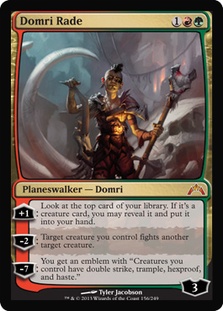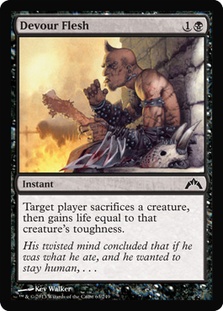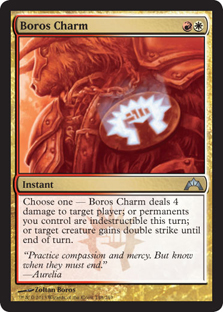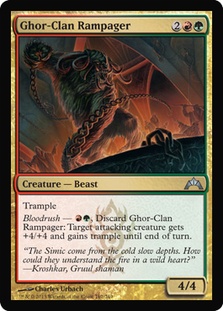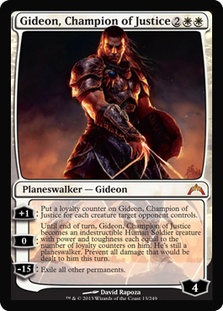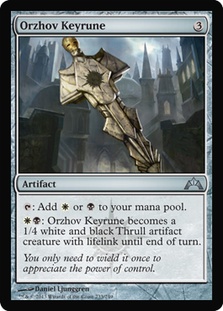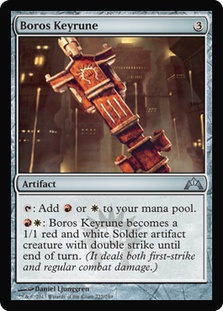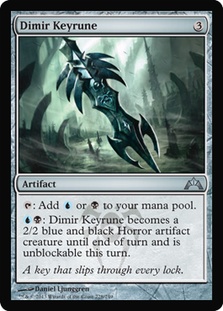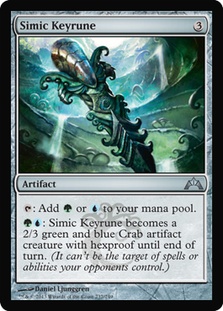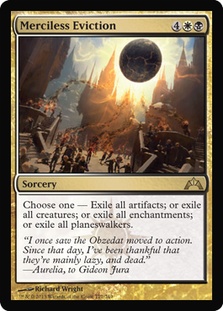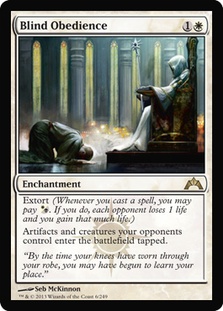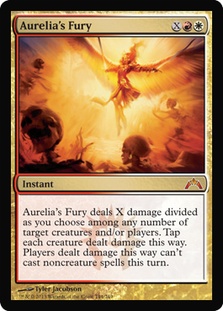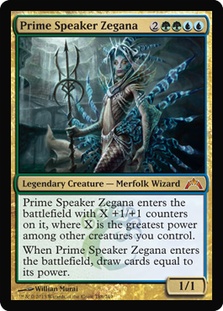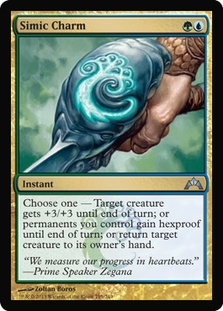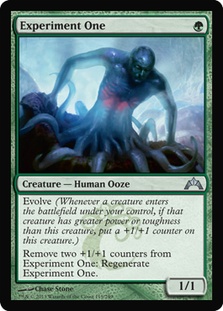"Does anybody really know how good the Gatecrash cards are? I mean, this is one of the toughest sets to evaluate ever, right?"
Would you rather it was easy?
Gatecrash has finally dropped, and there is no question that this is one of the most difficult nuts to crack in recent years, if not ever. It’s not that people think the set is bad per se, it’s just that the set doesn’t have as many easy, obvious hits as other recent sets. There are a disturbing number of cards that seem to exist in a space where few people are willing to take strong stances, as so many of the potentially dangerous cards go in very different directions than we are used to.
With so many difficult to evaluate cards, how are we supposed to get a jump on the competition? Are we really supposed to wait until Pro Tour Montreal to find out what the new hot cards are for Standard?
The difficult we do immediately. Impossible takes a little longer.
Over the course of this week, we are going to tackle each and every controversial new card. Rather than some arbitrary 1-10 or 1-5 system, we are going to focus on figuring out how to use each card, as well as begin to assess what the metagame of the future will look like.
Gold sets can be tricky since talking about Gruul kind of necessarily leads us to Boros and so on. Rather than some kind of a color order, we are going to approach the set from the position of its impact on Standard. Today, we cover existing strategies and what new tools they gained. Wednesday, we move on to new strategies made possible by Gatecrash cards. Finally, we conclude on Friday with something a little different…
You know which cards people have been shockingly silent on?
The planeswalkers.
That’s weird. You’d think the planeswalkers would be the first order of business. Aren’t they traditionally among the most hyped cards every time? They are also among the most important to determine if they will be stars or mere role-players. I guess we have to make sure to spend the proper time discussing how good the shocklands are and how much better Boros Charm is than Gruul Charm, huh?
We need to start somewhere, so let’s start with some strategies that can make use of the two new walkers. Up first, Jund:
Creatures (26)
- 4 Arbor Elf
- 4 Olivia Voldaren
- 4 Huntmaster of the Fells
- 4 Nightshade Peddler
- 4 Thragtusk
- 4 Izzet Staticaster
- 2 Deathrite Shaman
Planeswalkers (2)
Lands (22)
Spells (9)

Ok, maybe this is Jund, maybe it’s not. Likely, only Brad Nelson truly knows. Regardless, it is an archetype that may change its look a fair bit over the next several weeks at least partially in response to how the rest of the metagame shapes up as opposed to just adopting Gatecrash cards for their own raw power.
Why add Domri Rade? For a breakdown of Domri Rade’s raw power level, click here. He’s certainly not pushed to the limits here, but he does have a few nice synergies. To start with, even with just 26 creatures, we are still drawing over 43% of a card a turn with his plus ability. What’s better is we draw all gas off of it. Almost every creature in the deck is a bona fide threat.
An important trait of Domri Rade is his ability to start a fight immediately. This ability is going to be better in a build with Vampire Nighthawk or Wolfir Silverheart, but it is still solid here, primarily comboing with Nightshade Peddler and Thragtusk. Remember, even a Deathrite Shaman can kill a Thundermaw Hellkite if it has deathtouch.
That Jund, and Staticaster Jund in particular, can play a solid defensive game isn’t just about buying time to draw extra cards. We are also eventually threatening to create Rade’s emblem, which radically alters the rules of the game from then on.
The addition of Stomping Ground and Breeding Pool has a big influence on this (and most green decks’) mana base. It is important to remember to keep our "type count" high enough to make our M10s come into play untapped, but also look for places to shave shocklands if we can afford it (to gain some extra life). Stomping Ground and Breeding Pool are going to be two of the most influential cards in the new set, not only expanding the possible targets of Farseek but also drastically altering the nature of Arbor Elf.
Arbor Elf used to be much more difficult to use since you basically had to use five or six basic Forests to reliably count on him for mana. Anything other than B/G/W and you were looking at something relatively close to mono-green. Now any three-color green combination you want can use Arbor Elf with eight green duals. Plus, if you hybridize RUG with Jund or Jund with Naya or Naya with Bant, you can make full use of twelve untapped duals for turn 1 Arbor Elf. Arbor Elf might be the best Gatecrash card for a lot of people…
While he is quite fragile, Arbor Elf could help address Jund’s biggest problem: games when it doesn’t draw Farseek. It’s not clear what the mix should be between them and Deathrite Shaman, but I still like both. Shaman’s ability to disrupt undying, Gravecrawlers, Reanimator, flashback, and Snapcaster Mage is really good. Tracker’s Instincts even lets us backdoor some mana from the Shaman from time to time. Still, the possibility of using Arbor Elf to play Domri Rade on turn 2 is pretty enticing, to say nothing of turn 2 Staticaster killing an Experiment One or Stromkirk Noble before they grow out of hand.
There are more than a few new cards that push players in a creature-heavy direction. This makes Izzet Staticaster + Nightshade Peddler even better than usual. Remember, Olivia or Huntmaster with deathtouch is pretty brutal as well.
While I don’t have any main in this build, Devour Flesh is one of the most important new cards in the set. Staticaster Jund wants to stay threat-heavy main but would probably sideboard some. It’s not just good against hexproof (though it is amazing there, particularly against Geist of Saint Traft), it is also just a great removal spell for fatties when you can reliably clean up the little guys (which this much pinging is quite good at). It’s not just a Diabolic Edict with a drawback. It is also upside when you have to use it on yourself in a pinch. Mainly, though, it benefits from just being very well positioned.
Of course, this is certainly not the only way to play Jund. What about something without blue?
Creatures (16)
Planeswalkers (1)
Lands (25)
Spells (18)

With just sixteen creatures, we aren’t going to want Rade here (one or both Garruks are surely better). However, traditional Jund is much more likely to adopt Devour Flesh as a maindeck card. The minor life boost you give your opponent is not that big a deal since when you win you often win by a large margin. Current Jund decks really are more nonblue control than true midrange (like the Bloodbraid into Blightning builds of old).
While Devour Flesh is not great against Gravecrawler or Geralf’s Messenger, Pillar of Flame is. Lingering Souls can be annoying, but Thundermaw Hellkite and Bonfire gain extra value there. With small creatures easily taken care of, Devour Flesh is generally going to trade up and is particularly valuable for shoring up potential vulnerabilities to Geist of Saint Traft.
Another possible home for Domri Rade is in Naya, where getting up to nearly 30 creatures is not difficult.
Creatures (28)
- 4 Arbor Elf
- 4 Avacyn's Pilgrim
- 4 Huntmaster of the Fells
- 4 Restoration Angel
- 4 Thragtusk
- 1 Thundermaw Hellkite
- 4 Loxodon Smiter
- 3 Angel of Serenity
Planeswalkers (2)
Lands (24)
Spells (6)

28 creatures means Rade is hitting nearly half the time, and we still manage a full 20 legit threats. Angel of Serenity is just an absolutely fantastic end game, but Aurelia’s Fury actually opens up very powerful lines of play that Bonfire of the Damned never could. If you need a sweeper, Bonfire or possibly Mizzium Mortars are the places to look. However, on raw power, Aurelia’s Fury is just nuts, and a big mana Naya deck is the perfect place to capitalize on this power, which is broken down in depth here.
One of the biggest challenges to Naya is going to be perfecting its mana base. Gaining access to Arbor Elf is a major boost, but does require lots of basic Forests. Honestly, I really want at least six, but this build tries to get a little greedy to fit in five action lands. If you are playing eight mana creatures and Farseeks with no card draw, you are going to flood out. Playing lands that double as spells has been a successful recipe for past Jund and Naya decks. We have such good spell lands available to us that we should certainly be exploring how far we can push it.
Of course, Naya could also benefit from Boros Charm, though it does push the deck in a different direction than Domri Rade. Once you are pursuing Boros Charm, Ghor-Clan Rampager starts looking more attractive, and you start talking about a very different breed of Naya deck. Big mana Naya has its roots in the current Standard, while Naya Zoo hasn’t really been possible without Stomping Ground and Sacred Foundry. These new Zoo decks are going to be crucial to understand, and we will be diving into them on Wednesday.
Ok, Domri Rade is solid. Good, not great. Will be a quality tournament card, but like so many other planeswalkers is slightly overvalued at release because people always go nuts on them during preview season. His power level is similar to Ajani, Caller of the Pride, maybe one notch below. Ajani has certainly proven himself a fine tournament card, but he has also experienced a drop in price from $40 to $12, though he was more overhyped than Domri was. We’ll talk more about Domri Rade Wednesday when we look at the various Gruul decks on the horizon.
What about Gideon, Champion of Justice?
Come to think about it, I have heard exactly zero on this guy. Why?
I got to thinking about this today, and the conclusion I came to was that he doesn’t give the greatest first impression but is confusing enough to have people wanting to reserve judgment. Why is his first impression worse than Gideon Jura’s? To start with, just gaining loyalty isn’t as sexy as actually forcing the full-on attack. Next, the ability to use Gideon as spot removal made him very easy to see a clear and powerful use for.
This Gideon can soak up lots of damage but is more about being a giant attacker that lives through sweepers.
Creatures (25)
- 4 Champion of the Parish
- 4 Avacyn's Pilgrim
- 4 Silverblade Paladin
- 1 Wolfir Silverheart
- 2 Sublime Archangel
- 4 Loxodon Smiter
- 4 Experiment One
- 2 Wasteland Viper
Lands (23)
Spells (12)

One possible application of Gideon 4 is that of an anti-sweeper tool. This could be easily be a maindeck option, but it also works well as a sideboard card. Remember, against opponents without creatures, Gideon is essentially a 5/5 creature for four that can’t be hit by Supreme Verdict, Terminus, Mutilate, and Barter in Blood.
It’s interesting to consider Gideon against creatures, though, as he can gain loyalty so fast. This ability is strongest when you have creatures holding off your opponent’s creatures instead of removal. In such a situation, it would not be unusual for Gideon to gain five or more loyalty a turn. This presents an interesting puzzle for opponents. Can they attack into him to keep him blowing up the world? Is that even the greatest of their worries?
What if you drop Gideon against an opponent with three creatures while you have an Augur of Bolas defending you? Gideon is now at eight loyalty. Do they attack him or you? That is a lot of damage to try to deal Gideon, and he gains loyalty so fast. What if you follow it up with a Supreme Verdict then attack for eight? Alternatively, you can just plus him to hit twelve or more loyalty if you’d rather have board presence than damage.
Creatures (13)
Planeswalkers (3)
Lands (23)
Spells (21)

It should be noted that Dispel main may come into fashion depending on just how popular cards like Boros Charm turn out to be. It was already a fine sideboard card, but it’s not completely out of the question to maindeck one (or even more?!).
Gideon is just nutty against token-based strategies, effectively negating all 1/1 s on his own. If they don’t attack him, he quickly grows large enough to blow up the world (except himself). It is very curious just how good he is against no creatures (unsweepable 5/5) and how good he is against tons of creatures (where he gains unheard of amounts of loyalty per turn).
His strength against large numbers can be magnified if we can create a game state where are our opponent has lots of creatures that don’t deal much damage. What if we combined him with Jace, Architect of Thought? Now every creature is effectively -2. If our opponents attack Jace (as they probably will), Gideon threatens to bash for double digits.
Planeswalkers (10)
- 2 Liliana of the Veil
- 2 Sorin, Lord of Innistrad
- 1 Tamiyo, the Moon Sage
- 3 Jace, Architect of Thought
- 2 Gideon, Champion of Justice
Lands (26)
Spells (25)

Gideon + Jace + Curse of Death’s Hold aside (any two of which are totally awesome together, with all three creating a death grip on opposing creatures), this deck actually has a number of interesting things going on. Devour Flesh is absolutely fantastic here with Detention Sphere and Curse of Death’s Hold trying to make up for the lack of Pillar of Flames (for fighting back against Zombies).
Gideon can often come down and gain so much loyalty that he survives without any defense. Next turn you can gain even more loyalty (after effectively preventing a lot of damage) then sweep the board and have a massive board advantage against most opponents. Lingering Souls tokens also interact interestingly with Gideon since they let you gain tons of loyalty each turn without Gideon actually getting hit (assuming your opponent is playing dudes).
Orzhov Keyrune is my favorite of the new cycle, with an honorable mention to Boros Keyrune. Orzhov is the colors of all of the sweepers, which work great with Keyrunes, plus it can actually block and live. Rakdos Keyrune was the clear best of the first five for this exact reason. It is nice to be able to turn your mana into threats, but being able to actually defend without losing your mana is awesome. A 1/4 creature isn’t going to kill people as fast as the Rakdos one, no question, but gaining some extra life is always much appreciated. This one certainly isn’t as good as Rakdos’s, but it is playable.
While I am not sure Boros Keyrune is even as good as Dimir’s (they are close), it is the more interesting of the two. If Dimir’s is better, it is because a U/B deck is far more likely to actually want a Keyrune in general. Boros’s, on the other hand, is likely not good enough but has backdoor chances of being a part of some sweet double strike deck, perhaps capitalizing on the abundance of good double strikers (Silverblade Paladin, Boros Charm, Ajani Caller of the Pride, Aurelia, even Deft Duelist) and good pump spells (Kessig Wolf Run, Rancor, Ghor-Clan Rampager, Slayers’ Stronghold, Wolfir Silverheart, and so on).
Actually, come to think of it, Simic’s is pretty cool. A 2/3 hexproof creature isn’t a great body, but it is really awesome that late game you can make a threat that is hexproof and sweeper proof that is also part of your mana base. Regardless of how it shakes out, I just like that there are multiple interesting Keyrunes, unlike Return to Ravnica where one is just several tiers above any of the rest (and above any of these five).
I considered Merciless Eviction, which I think will prove to be a fine Constructed card. It just isn’t really appropriate for this build, as it is basically just a worse Terminus for us. To really take advantage of Merciless Eviction, we want one of a few things to be true.
1) You want to be able to hit noncreatures with it. A lot of control decks can have a real weakness to planeswalkers, and Merciless Eviction can be very strong against them. Just look how much it would wreck this Esper deck! Being able to find solutions to artifacts and enchantments is not usually important, but it can be game winning when it’s relevant.
2) You are just splashing white. Terminus is a great sweeper for any white mage, but what if you aren’t really a white deck? For instance, what if we were playing Mono-Black with four Godless Shrines and four Isolated Chapels? Or perhaps we are Jund with Lingering Souls off of three white shocklands and four Farseeks? The point is that giving such a powerful sweeper to non-dedicated white decks is a new thing. Mutilate exists, but exiling all is a very different sort of thing.
Another card we should consider is Blind Obedience. I put two in here to start, but I kind of want more already… The card is really strong.
It seems relatively unassuming, but there is a lot hidden under the hood. To begin with, the extort mechanic is just more powerful than a lot of people realize. Throne of Bone isn’t exactly a killer, but this also damages your opponent, making it roughly 2.5 times better of an output than just gaining a life (since damage > life gain). Also, this triggers off of all of your spells, meaning you are basically just going to be draining your opponent all of the time.
Normally, the big limiting factor of extort creatures is their vulnerability to removal. When it appears on an enchantment, most opponents are stuck having to race (which Blind Obedience helps a lot with). Every card draw spell is made so much stronger when it drains your opponent for one as a bonus.
It isn’t just the extort ability that is so good with Blind Obedience, though. Making creatures come into play tapped is deceptively strong. Most notably, it invalidates haste as a mechanic. No more surprise Hellriders, Falkenrath Aristocrats, or Thundermaw Hellkites. On top of that, it provides a little extra insurance against flash creatures. They can still attack once before you can sweep them, but Restoration Angel into an empty board can’t actually block your guy by surprise. If fact, if they Blink anyone, that creature won’t be able to block either.
This Esper deck doesn’t take full advantage of Blind Obedience, however, since it doesn’t have a bunch of creatures that people would want to block. If you put Blind Obedience in a deck with such creatures, now your opponent is effectively always a turn behind.
It seems like no one is big on Blind Obedience yet, but it is on my shortlist of sleepers for the set. The card just seems so strong. It nearly invalidates burn as a strategy all by itself! As funny as it sounds, there are actually a lot of similarities between Blind Obedience and Bitterblossom. Bitterblossom had way better tribal support, but it was initially underestimated by most because it was power in a place we don’t usually get it.
Two-mana enchantments that draw us a card (of sorts) every turn. While Bitterblossom’s was a 1/1 for a life instead of a mana, Blind Obedience is actually giving us a number of minor abilities that work together to make a card (Charms, if you will). I wouldn’t consider draining my opponent to be worth a card, but draining my opponent twice generally is (which card draw and flashback easily enable). Additionally, randomly thwarting haste, flash, or blocking is super good when it is good. While none of these abilities (gaining life, dealing damage, tapping creatures) is a superstar on its own, you actually get to do all three rather than having to choose!
Blind Obedience is not quite as strong as Bitterblossom, but I think it is going to sneak up on people. I mean, most people consider the card to be bulk, right? Part of it is that most people are underestimating extort to begin with. Try drafting extort and then tell me your thoughts on the mechanic…
One of the Gatecrash cards everyone is talking about is Aurelia’s Fury. Everyone seems to agree it is quite powerful, but where does it actually go? After all, a lot of Boros decks aren’t really going to have that kind of mana, right?
Creatures (13)
Lands (25)
Spells (22)

U/W/R decks anywhere on the spectrum between tempo and control make excellent use of Aurelia’s Fury, sometimes turning it into a combination Cryptic Command / Comet Storm. There are a lot of low toughness creatures in Standard right now, but even just tapping the big ones at instant speed is great. Having added answers to planeswalkers as well as just closing games is much appreciated. Geist of Saint Traft in particular really loves when you have the ability to tap creatures.
Remember, you don’t need to play twelve shocklands in a three-color deck! As long as you have enough lands that can untap your M10s and don’t need to play a one-drop on turn 1, we want to look to shave and give ourselves a little extra life.
Blind Obedience in a nonblack deck? Yeah, what of it? Who cares if there is a little Orzhov symbol on the card? That card is secretly Azorius, as card draw and flashback is way more important than black mana. Geist of Saint Traft happens to be really sweet with Blind Obedience since it makes blocking a real pain.
Not every white big mana deck is a Blind Obedience deck, however. If you are grinding, the card is fantastic. If you are setting up big haymakers, however, the draining isn’t always even going to be worth the mana. For instance:
Creatures (16)
Lands (26)
Spells (19)

One possible future for Bant Control is as more of a ramp deck. Ranger’s Path improves a lot with the printing of Breeding Pool and Stomping Ground. Additionally, Prime Speaker Zegana is one of the most powerful new cards, as it is Braingeyser that you can Cavern out that is super easy to abuse over and over. Just as Sphinx’s Revelation is so strong in part because it gives you some life to help stay alive to use all these cards, so too does Zegana (by giving you a giant blocker). On top of all of this, she synergizes extremely well with Restoration Angel and Thragtusk, which is about as good as company as you can ask for.
All of this ramp stuff is so strong that I kind of just want to play some Avacyn’s Pilgrim or Arbor Elf and ramp even faster. Even Somberwald Sage could be an option. I was initially interested in Gyre Sage, but Finkel pointed out to me that you don’t get any mana out of him until you have already evolved him, which means you have to get two counters to just not be behind. The card still has uses, but it is nowhere near the Lotus Cobra it looked at first glance.
Alchemist’s Refuge might see its stock rise, as cards like Zegana are interesting at instant speed (particularly with Cavern of Souls making counterspells useless).
Of course, Bant Control isn’t the only Bant deck in the format. Bant Hexproof may have mostly fallen off the map after its dominating performance at GP Atlantic City, but it is exactly the type of deck that can surprise people if they underestimate it.
Creatures (20)
Lands (21)
Spells (20)

The biggest addition to Bant Hexproof is Breeding Pool, no question, since it effectively adds Arbor Elf. Having eight ways to make a turn two Geist of Saint Traft is aggressive.
Simic Charm might be too slow, but it gives us a lot of options. It can remove a key blocker, save a Silverblade Paladin from removal, combine with double strike to do an extra six damage, or just help Geist of Saint Traft keep attacking. Besides, Curiosity is probably not where you want to be with this sort of a deck. The game isn’t going to go very many turns, so you won’t get that many draws off of it and the cards you draw aren’t always high impact. You drew an extra aura? I bet that is turning the game around enough to justify the extra damage you didn’t do this turn…
A major challenge for Bant Hexproof decks is going to be the printing of Devour Flesh. It just means there will be even more Edicting going on, which is very annoying for this strategy to try to fight. The other big challenge is that putting Spectral Flight on your Invisible Stalker is going to be far riskier now that we live in a world where everyone is going to be Gruul Charming each other…
Of course, Arbor Elf already had some homes. For instance, G/B Ooze decks:
Creatures (26)
- 4 Arbor Elf
- 3 Strangleroot Geist
- 4 Predator Ooze
- 2 Wolfir Avenger
- 1 Ulvenwald Tracker
- 3 Dreg Mangler
- 2 Deadbridge Goliath
- 3 Lotleth Troll
- 4 Experiment One
Planeswalkers (2)
Lands (23)
Spells (11)

This archetype doesn’t really gain a lot unless you want to change directions a bit. Experiment One is extremely strong but is just kind of shoehorned in here. Devour Flesh is a nice addition but is hardly that important.
It’s possible that the way this deck evolves is by adopting a third color. Zegana is pretty interesting, but I wonder if adding white or red even leaves you still playing an Ooze deck. Adding a third color is normally easy, but if you try to do it and keep Ooze, your mana base might just need Farseek, which would hurt to take a turn off to do.
The final archetype I’d like to talk about today is Mono-Red Aggro.
While you could go something like this, what metagame are you trying to beat? Is maindeck Skullcrack really a thing? This format seems so fast and brutal.
A lot of people are going to be experimenting with splashing white for Boros Charm or green for Ghor-Clan Rampager, but it is far from clear that it would actually be an upgrade over straight red. Of course, there will also be true Boros and Gruul decks, but we will be exploring them in greater detail Wednesday. As for red with Boros Charm Rampager, here are some possible starting points:
Creatures (27)
- 4 Stromkirk Noble
- 4 Hellrider
- 2 Stonewright
- 4 Lightning Mauler
- 1 Thundermaw Hellkite
- 4 Ash Zealot
- 4 Rakdos Cackler
- 4 Boros Reckoner
Lands (23)
Spells (10)

Creatures (31)
- 4 Stromkirk Noble
- 4 Hellrider
- 2 Stonewright
- 4 Lightning Mauler
- 1 Thundermaw Hellkite
- 4 Ash Zealot
- 4 Rakdos Cackler
- 4 Ghor-Clan Rampager
- 4 Boros Reckoner
Lands (23)
Spells (6)

Today’s lists are not that great a departure from the existing metagame, but that makes sense since we stuck to just the existing strategies. Wednesday is going to be a lot of fun, as Gatecrash has a number of cards just below the surface. We’ll probably make a dozen or more new strategies made possible by Gatecrash, and maybe only a couple turn out good. Still, you can’t be sure which yet. Who would have guessed the Delver of Secrets + Snapcaster Mage + Runechanter’s Pike deck from the Innistrad preview was going to be one of the ones that actually made it? Wouldn’t have been one of my first five guesses.
What decks do you want to see on Wednesday? What are your Top 5 nonland Gatecrash cards? I hope everyone had as good a time at their Prerelease as I did on the Magic Cruise one!
See you Wednesday!
Patrick Chapin
"The Innovator"
 |
The first rule of Dimir Guild is you do not talk about Dimir Guild. The second rule of Dimir Guild is you do NOT talk about Dimir Guild. My official response? Izzet and proud… |

